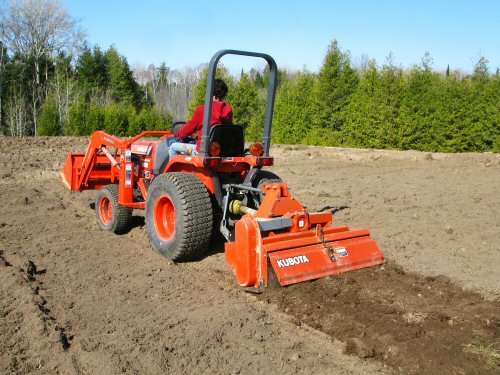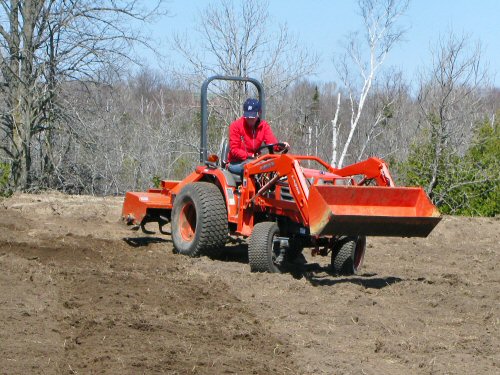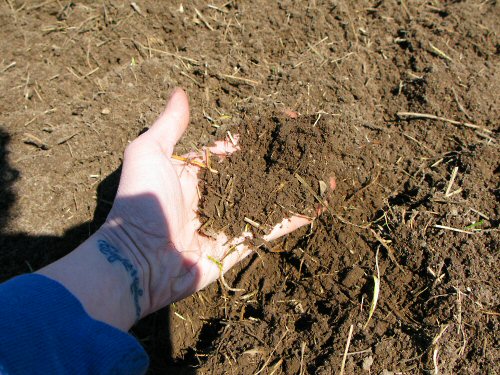
Beautiful weather, around 60°F (15°C) in the full-on sun, with a crisp undercurrent of a breeze… What could be nicer for the first full day of fieldwork?! Lynn, Mel and Jordan came by at 8:30 am, and Tara joined in a little later on. We’re still working on preparing the beds, so the main action was raking and ROTOTILLING…busting up that sod. And everyone’s gearing up for the season, learning where things are and how to do…stuff. Like…rototilling! Mel tries her hand at it for the first time (above)—the Kubota compact tractor is as reliable, steady, and undaunting as ever…

Tara also rototills for the first time. Here, she executes what looks like a nimble little turn…

Mel inspects the results of a pass with the rototiller, checking out the effect of tilling at different speeds. And the tiny farming goes on… (Photos 2 and 3 by Mel)




Good to see your underway…
The soil “looks” good. Did you have to do extra tests etc, before you committed to your new location?
You must have been quite confident that your new site would produce adequate yields. Was this a concern with CSA etc and are you planning on proucing the same number of shares or taking a more conservative approach?
I had to comment and just say – the work you document and do each day is very inspiring. We are working towards a plan that we hope includes a tiny farm of some sort. In the meantime, we live through you guys!
Thanks.
That is a sweet tractor! Sure beats the honda tiller we use.
I always think it is so tempting to use a rotavator on the soil, it would be so much easier and save so much time BUT it would chop up the pernicious weeds into 400 pieces instead of 4. Dilemma/
I love your little tractor! I wish my humble allotment plot was big enough to justify owning one!
Hello! I love your blog!
My question is how do you control weeds on your tiny farm? I have just tilled my tiny garden and am considering how to do battle with the beasties. They took over the garden last year.
I was thinking that I would lay down either some burlap if I can get some or newspaper and cover that with straw. I don’t really care if the weeds are still alive or whatever, as I’ve been told, as long as they don’t take over like last year.
I would love to hear back from you!
Thanks
NZneil: We basically plunged in. My quick checklist (which I think I mostly posted here on the blog) was basically: no obvious invasive plants, decent topsoil texture and depth, and mainly-grass hay fields growing healthily. I’m assuming no major pH or nutrient imbalances, at least, none that can’t begin to be fixed in the first season with relatively large local applications of compost and alfalfa (see below).
The main concern is the sod decomposing quickly and thoroughly enough not to get in the way of early crops. Unknowns are pests (the particular chance of wireworm after sod?!), which includes the possibility of deer.
As general backup, we purchased about 5 tons of certified organic composted sheep and cow manure (classed as compost, so it can be applied directly)—it’s not a lot for 1-2 acres, but should be enough for strategic use. We’re also getting a ton of certified organic alfalfa pellets as a general purpose fertilizer, which is supposed to be good for an acre of veggie crops if used as the sole source of fertility.
We also have an anti-deer electric fence plan of sorts, just in case. There are lots of deer in the area, there’s a fair bit of wooded land adjacent to the unfenced fields, but the deer are wild and easily scared, not all suburban and bold, and we haven’t heard of deer problems in the area.
The CSA membership goal for Year 1 is small, so I can’t imagine anything that would prevent us from having a great share season. We wouldn’t offer CSA otherwise. This is essentially the same soil and climate as at the old farm (we’re only around 30km away), and I’ve dealt with fairly extreme conditions (drought, weeds, pests) there with no big problems.
(The longer-range plan is composting, green manure, a small amount of on-farm animal manure, and possibly for this year and next, some bulk manure from the farm next door, which is certified organic beef, poultry and grain. There is no intention of buying in compost or any sort of fertilizer as an ongoing thing.)
And…we’ll see what happens! :)
James: Thanks. Hope this season continues to be…entertaining!
brandy, Liz: Yeah, it’s real friendly, and it sure comes in handy. But we could do without, there’s always our Troy-Bilt Horse (rear-tine walking rototiller). And the Tanaka mini-cultivator (a weed eater with a cultivator attachment). And willing hands!
Matron: That’s always an issue. Luckily, in this case, we’re chopping up mainly orchard grass, it’s not anything super-invasive that can grow back from tiny pieces. The grass will attempt to come back from even tiny clumps of sod, but it’s much easier to deal with that way!
The Rockin Traddy: Mulch is probably the way to go. If you can get straw that hasn’t been sprayed (herbicides can wash off and hurt your veggies), that sounds great. Spread it 4-6″ deep (too thin and you’ll still get weeds) and you should effectively block all your weeds, keep your soil temperature stable, and conserve a ton of moisture. Like a miracle! I’ve experimented with straw and grass clippings, and also green IRT plastic (similar to black plastic), and they all work great if you use enough (although I don’t like using plastic). Mulch rules (it just that it gets expensive to spread non-plastic over a larger garden, like, a half acre or more, if you don’t have your own supply)! :)
I am curious about the wheel clearance of your tractor. From the picture above, I would say you have about 30-ish”. I was wondering if there was tractor in the same category (and price range!) that have 48″ clearance.
The reason I am asking is that I have tiny farm plan of my own, and I think I might want to do permanent bed. In which case the choice of tools to use would largely be conditioned by the beds width (or the the other way around).
While on the subject, how much clearance do you need to turn the tractor around?